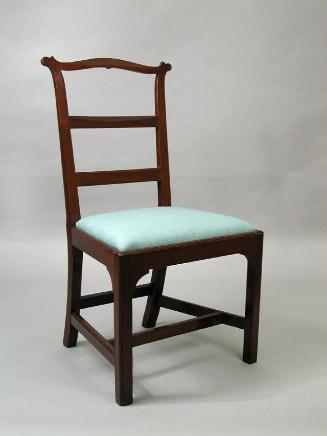Side Chair
Furniture MakerChair frame made by the school of
Eliphalet Chapin
(American, 1741 - 1807)
EmbroidererSeat cover embroidered by
Mary Chaplin
(American, 1748 - 1816)
EmbroidererReplacement seat cover embroidered by
Marina Davison
(American)
Date1770-1771
MediumCherry, pine, embroidery seat cover
DimensionsPrimary Dimensions (overall height x width x depth): 37 1/4 x 21 3/8 x 19 1/2in. (94.6 x 54.3 x 49.5cm)
ClassificationsFurniture
Credit LineGift of Lillian Bjerg Steuber, in honor of her mother, Ella Davison Bjerg
Object number1997.58.0a,b
DescriptionCherry side chair in the Chippendale, or rococo, style, with a scalloped crest rail, a pierced, Gothic-style splat, straight front legs, and a removable slip seat (replaced). The back of the chair is formed by a crest rail atop two stiles. The top edge of the crest rail has three arches, with a rounded ear at each end. Centered below the crest rail is a pierced splat with interlocking pointed arches and a trefoil creating a Gothic-style pattern. The front and the bottom center edge of the crest rail are carved with two lidded arches and a continuation of the broad sweep of the arches from the crest rail below. The splat is joined at the bottom to a tapered splat shoe, just above the back seat rail. Above the seat, each stile is slanted back. Below the seat, each stile forms a back leg that is slanted toward the center back of the chair. The seat is trapezoidal, with a removable slip seat with needlework upholstery (the slip seat is replaced). The slip seat sits just inside the four seat rails at the top of the legs. The straight front legs extend from the height of the seat down to a plain foot. The back and each side of the chair have a plain, rectangular stretcher joining the legs. A rectangular medial stretcher joins the two side stretchers.
Condition: The front seat rail, the front legs, and the side and medial stretchers are badly scratched and worn. The top corners of each front leg are further damaged and worn. An arched section of wood in the lower right center of the splat has split. The joints attaching the front seat rail and front legs have been reinforced with nails. The front corner blocks are replaced. The frame has a later resin finish over a possible original finish. The needlework and webbing on the slip seat are twentieth-century additions. The original needlework cover is stitched to a linen backing.
Design and Construction Details:
Design. The top edges of the front and side seat rails, the top of the legs, and the front exterior edge of each front leg all have a line of molding consisting of an ovolo flanked by a fillet.
Chair Frame. The crest rail is supported on a tenon at the top of each stile. Above the seat, the back of each stile is rounded. The splat is tenoned into the crest rail. Extra pieces of wood are glued to the lower center section of the back of the crest rail, to provide additional support for the top of the crest rail. The crest rail is carved through to accommodate the arched and lidded shapes at the top of the splat; the sides of the arches are deeply chamfered. The splat is tenoned into the splat shoe at the top of the back seat rail. The splat is nailed down on top of the back seat rail. The back seat rail is tenoned and pinned into the stiles. Each side seat rail is tenoned through the stile; the joint is secured with a wooden pin through the side of the stile (there are no wedges through the back of the tenon). Each side seat rail is tenoned and pinned into the top of the front legs. The front seat rail is tenoned into the top of the front legs. The interior top edge of the front and side seat rails, as well as the top of each front leg, have a rabbet to support the upholstered slip seat. The interior back corners of the seat frame have quarter-round corner blocks held in place with glue and nails. The interior front corners of the seat frame each have a triangular corner block (replaced) nailed in place. The interior corner of each leg is canted. The side and back stretchers are tenoned and pinned into the lower portion of the legs. The medial stretcher is dovetailed into the side stretchers.
Upholstered Slip Seat and Needlework Cover. The side chair is accompanied by a removable slip seat upholstered with a twentieth-century needlework cover, and a separate, original needlework cover dated 1770. On the slip seat, the top upholstery consists of a pink, white, and blue floral design on a field of deep blue wool needlework (replaced). Below this is a canvas undercover, over cotton and grass stuffing, sackcloth (original), webbing (replaced), and a trapezoidal wooden frame (original). The needlework and undercover are held in place with nails through the underside of the frame. The original needlework cover consists of a flame-stitch (Irish stitch) pattern of red, blue, brown, green, and white wool thread on a linen backing. The right side of the original cover is marked "MARY/ CHAPLIN/ JUNIOR 1770".
Condition: The front seat rail, the front legs, and the side and medial stretchers are badly scratched and worn. The top corners of each front leg are further damaged and worn. An arched section of wood in the lower right center of the splat has split. The joints attaching the front seat rail and front legs have been reinforced with nails. The front corner blocks are replaced. The frame has a later resin finish over a possible original finish. The needlework and webbing on the slip seat are twentieth-century additions. The original needlework cover is stitched to a linen backing.
Design and Construction Details:
Design. The top edges of the front and side seat rails, the top of the legs, and the front exterior edge of each front leg all have a line of molding consisting of an ovolo flanked by a fillet.
Chair Frame. The crest rail is supported on a tenon at the top of each stile. Above the seat, the back of each stile is rounded. The splat is tenoned into the crest rail. Extra pieces of wood are glued to the lower center section of the back of the crest rail, to provide additional support for the top of the crest rail. The crest rail is carved through to accommodate the arched and lidded shapes at the top of the splat; the sides of the arches are deeply chamfered. The splat is tenoned into the splat shoe at the top of the back seat rail. The splat is nailed down on top of the back seat rail. The back seat rail is tenoned and pinned into the stiles. Each side seat rail is tenoned through the stile; the joint is secured with a wooden pin through the side of the stile (there are no wedges through the back of the tenon). Each side seat rail is tenoned and pinned into the top of the front legs. The front seat rail is tenoned into the top of the front legs. The interior top edge of the front and side seat rails, as well as the top of each front leg, have a rabbet to support the upholstered slip seat. The interior back corners of the seat frame have quarter-round corner blocks held in place with glue and nails. The interior front corners of the seat frame each have a triangular corner block (replaced) nailed in place. The interior corner of each leg is canted. The side and back stretchers are tenoned and pinned into the lower portion of the legs. The medial stretcher is dovetailed into the side stretchers.
Upholstered Slip Seat and Needlework Cover. The side chair is accompanied by a removable slip seat upholstered with a twentieth-century needlework cover, and a separate, original needlework cover dated 1770. On the slip seat, the top upholstery consists of a pink, white, and blue floral design on a field of deep blue wool needlework (replaced). Below this is a canvas undercover, over cotton and grass stuffing, sackcloth (original), webbing (replaced), and a trapezoidal wooden frame (original). The needlework and undercover are held in place with nails through the underside of the frame. The original needlework cover consists of a flame-stitch (Irish stitch) pattern of red, blue, brown, green, and white wool thread on a linen backing. The right side of the original cover is marked "MARY/ CHAPLIN/ JUNIOR 1770".
Status
Not on view












